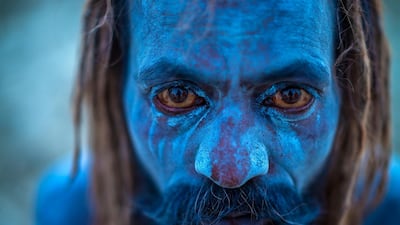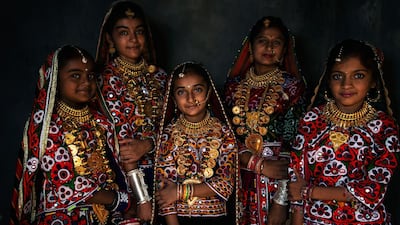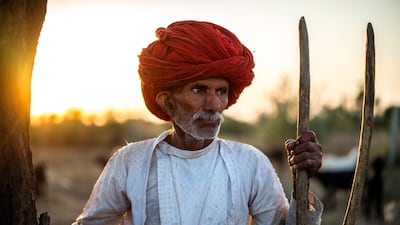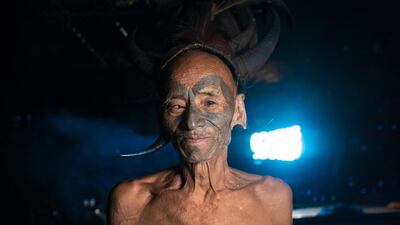A portrait of a pink-cheeked Drokpa woman from Ladakh in India's far north, wearing a goatskin cape, chunky silver jewellery and a headdress of flowers. A wrinkled woman from the Apatani tribe in Arunachal Pradesh in the country's north-east, with nose plugs (originally intended to make women of the tribe less attractive) and dark facial tattoos. A Raika male, a traditional pastoralist from the western desert state of Rajasthan, with a gargantuan red turban framing his forehead.
I choose to call these tribes the last avatar as they are the only keepers of our true Indian culture. They are the reflection of our heritage
These are some of the dramatic portraits from The Last Avatar – a project started by Aman Chotani, 31, an Indian travel and lifestyle photographer. With a master's degree in photography, Chotani has spent years documenting the culture and lives of people in different parts of the world.
In The Last Avatar, which he began in 2018, he documents the traditions of the tribal communities of India, before they vanish for ever. Adivasis, or the indigenous tribes of India, make up 8.6 per cent of the country's population, or 104.2 million people, according to the last Census of India in 2011.
In some of the north-eastern states, such as Arunachal Pradesh, Meghalaya, Mizoram and Nagaland, the majority of the population is tribal. Many of the tribes live in remote forested regions, with little access to education. Some are not immune to the onslaught of modernity, however, with mobile phones and television sets wheedling their way into some communities.
Chotani planned for The Last Avatar to form a photo book, but it has since expanded into a digital project complete with Instagram account that he runs with Vishal Bali, Stanzin Chokphel and Roohani Sawhney. He shortlisted 25 tribes from an exhaustive list of 645, and has so far photographed half of them.
So, what inspired him to start the project? “It’s the beautiful people I met, the enchanting places I visited and in particular my guru, Louis Kleynhans, an award-winning photographer, whom I used to assist in Durban, South Africa. He used to cover the local tribes in the jungles in Africa, and also helped in building their communities, and that’s what I started doing when I came back to India,” he says. “I started travelling and documenting the tribes and got into sustainable tourism, wanting to support our culture by telling the stories out there.”
Chotani is full of fascinating insights about the people he meets. "Men in Rajasthan usually grow long moustaches. In fact, moustaches in Rajasthan are symbolic of one's social status. But have you ever thought about why it is given so much importance there? Rajasthan has been a desert state, and the moustache works as a filter. Every small thing has a logic behind it," he says.
"The Raikas in Rajasthan, are recognised by their distinctive red turbans, but not many people know that the turban performs multiple functions – from saving them from scorching heat to being a makeshift pillow to rest on, a rope when in need or simply to accommodate small essentials needed during travels."
It is not always easy to photograph these tribal communities – many are shy of strangers and social contact. "We started our journey through schools, took workshops there and got connected to the people of the village, and then connected with their families. And when they got comfortable with me, I started shooting them," Chotani says. This takes him anywhere between one and three months.
The process has been enriched along the way. "As I started working with them and my interaction moved to a more personal level, they started sharing their stories and their life experiences," says Chotani. "I started understanding them, their beliefs, their traditions and their customs. Living with them, rejoicing in their festivals and special occasions made me understand how warm and welcoming their hearts are.
“Their lives are all about sustainability and community strength. The Apatani tribe in Arunachal Pradesh collectively work on each other’s farms, use commonly owned resources equitably and even utilise waste water for fish farming.
"A few years ago, I was in Ziro valley in Arunachal Pradesh. Late at night, our bike broke down and some tribal men found us. They took us with them. I wasn't sure if that was the right decision, but we did not have many options. They took us to a social gathering with some great food, music and dance.
“Apparently, they had a match and their team had lost and they were celebrating that. Imagine. We celebrate victory, they were celebrating their loss. Also, later, they took us to the winning team’s celebration. A small incident, but so much to take from it. This shows how deep-rooted their ideologies are.”
Chotani is not only a photographer; his involvement and plans go deeper. "As a part of this project, we are publishing our first book in April, and then a series of books covering all the tribes of India and then around the world. It is being designed in a way that it gives you an understanding of how enriching our indigenous systems are.
"We also hold cultural workshops in the tribal areas that we have been travelling to. These are intended to help the younger generation realise the importance of their traditions. Even in the remotest regions, mobile phones and TVs have made their presence, and 50 years from now, nothing will be the same."
Chotani is developing "art labs" across these regions to educate school students of various tribes about their traditional art forms, rituals, language and culture. "For example, the Drokpas of Ladakh raised the concern of their language becoming unpopular among the younger generations, and how it is close to being extinct. So, such aspects will be identified and added to the curriculum," he says. Most importantly, each lab will have a customised curriculum designed in accordance with the needs of that particular community.
“I choose to call these tribes the last avatar as they are the only keepers of our true Indian culture. They are the reflection of our heritage,” Chotani says. We need not develop them, but rather we need to learn from them. They have sustained themselves and survived without being dependent on any modern-day amenities or technologies. We aim to trace these original knowledge holders, and document and preserve their practices to create a cultural archive for our future generations.”
Britain's travel restrictions
- A negative test 2 days before flying
- Complete passenger locator form
- Book a post-arrival PCR test
- Double-vaccinated must self-isolate
- 11 countries on red list quarantine
Married Malala
Malala Yousafzai is enjoying married life, her father said.
The 24-year-old married Pakistan cricket executive Asser Malik last year in a small ceremony in the UK.
Ziauddin Yousafzai told The National his daughter was ‘very happy’ with her husband.
Islamophobia definition
A widely accepted definition was made by the All Party Parliamentary Group on British Muslims in 2019: “Islamophobia is rooted in racism and is a type of racism that targets expressions of Muslimness or perceived Muslimness.” It further defines it as “inciting hatred or violence against Muslims”.
Benefits of first-time home buyers' scheme
- Priority access to new homes from participating developers
- Discounts on sales price of off-plan units
- Flexible payment plans from developers
- Mortgages with better interest rates, faster approval times and reduced fees
- DLD registration fee can be paid through banks or credit cards at zero interest rates
SHAITTAN
%3Cp%3E%3Cstrong%3EDirector%3A%20%3C%2Fstrong%3EVikas%20Bahl%3Cbr%3E%3Cstrong%3EStarring%3A%20%3C%2Fstrong%3EAjay%20Devgn%2C%20R.%20Madhavan%2C%20Jyothika%2C%20Janaki%20Bodiwala%3Cbr%3E%3Cstrong%3ERating%3A%20%3C%2Fstrong%3E3%2F5%3C%2Fp%3E%0A
Infiniti QX80 specs
Engine: twin-turbocharged 3.5-liter V6
Power: 450hp
Torque: 700Nm
Price: From Dh450,000, Autograph model from Dh510,000
Available: Now
The specs: 2018 Volkswagen Teramont
Price, base / as tested Dh137,000 / Dh189,950
Engine 3.6-litre V6
Gearbox Eight-speed automatic
Power 280hp @ 6,200rpm
Torque 360Nm @ 2,750rpm
Fuel economy, combined 11.7L / 100km
Points Classification
1. Marcel Kittel (Germany / Quick-Step) 63
2. Arnaud Demare (France / FDJ) 38
3. Andre Greipel (Germany / Lotto) 25
4. Sonny Colbrelli (Italy / Bahrain) 24
5. Mark Cavendish (Britain / Dimension Data) 22
6. Taylor Phinney (U.S. / Cannondale) 21
7. Geraint Thomas (Britain / Team Sky) 20
8. Thomas Boudat (France / Direct Energie) 20
9. Stefan Kueng (Switzerland / BMC Racing) 17
10. Michael Matthews (Australia / Sunweb) 17
UAE currency: the story behind the money in your pockets
ASSASSIN'S%20CREED%20MIRAGE
%3Cp%3E%0DDeveloper%3A%20Ubisoft%20Bordeaux%0D%3Cbr%3EPublisher%3A%20Ubisoft%0D%3Cbr%3EConsoles%3A%20PlayStation%204%26amp%3B5%2C%20PC%20and%20Xbox%20Series%20S%26amp%3BX%0D%3Cbr%3ERating%3A%203.5%2F5%3C%2Fp%3E%0A
MATCH INFO
Fixture: Thailand v UAE, Tuesday, 4pm (UAE)
TV: Abu Dhabi Sports
Company%C2%A0profile
%3Cp%3ECompany%3A%20Zywa%3Cbr%3EStarted%3A%202021%3Cbr%3EFounders%3A%20Nuha%20Hashem%20and%20Alok%20Kumar%3Cbr%3EBased%3A%20UAE%3Cbr%3EIndustry%3A%20FinTech%3Cbr%3EFunding%20size%3A%20%243m%3Cbr%3ECompany%20valuation%3A%20%2430m%3C%2Fp%3E%0A
The biog
Family: wife, four children, 11 grandchildren, 16 great-grandchildren
Reads: Newspapers, historical, religious books and biographies
Education: High school in Thatta, a city now in Pakistan
Regrets: Not completing college in Karachi when universities were shut down following protests by freedom fighters for the British to quit India
Happiness: Work on creative ideas, you will also need ideals to make people happy
The specs: 2018 Nissan 370Z Nismo
The specs: 2018 Nissan 370Z Nismo
Price, base / as tested: Dh182,178
Engine: 3.7-litre V6
Power: 350hp @ 7,400rpm
Torque: 374Nm @ 5,200rpm
Transmission: Seven-speed automatic
Fuel consumption, combined: 10.5L / 100km
AWARDS
%3Cp%3E%3Cstrong%3EBest%20Male%20black%20belt%3A%20%3C%2Fstrong%3ELucas%20Protasio%20(BRA)%3Cbr%3E%3Cstrong%3EBest%20female%20black%20belt%3A%20%3C%2Fstrong%3EJulia%20Alves%20(BRA)%3Cbr%3E%3Cstrong%3EBest%20Masters%20black%20belt%3A%3C%2Fstrong%3E%20Igor%20Silva%20(BRA)%3Cbr%3E%3Cstrong%3EBest%20Asian%20Jiu-Jitsu%20Federation%3A%3C%2Fstrong%3E%20Kazakhstan%3Cbr%3E%3Cstrong%3EBest%20Academy%20in%20UAE%3A%20%3C%2Fstrong%3ECommando%20Group%2C%20Abu%20Dhabi%3Cbr%3E%3Cstrong%3EBest%20International%20Academy%3A%3C%2Fstrong%3E%20Commando%20Group%2C%20Abu%20Dhabi%3Cbr%3E%3Cstrong%3EAfrican%20Player%20of%20the%20Year%3A%20%3C%2Fstrong%3EKatiuscia%20Yasmira%20Dias%20(GNB)%3Cbr%3E%3Cstrong%3EOceanian%20Player%20of%20the%20Year%3A%20%3C%2Fstrong%3EAnton%20Minenko%20(AUS)%3Cbr%3E%3Cstrong%3EEuropean%20Player%20of%20the%20Year%3A%3C%2Fstrong%3E%20Rose%20El%20Sharouni%20(NED)%3Cbr%3E%3Cstrong%3ENorth%20and%20Central%20American%20Player%20of%20the%20Year%3A%20%3C%2Fstrong%3EAlexa%20Yanes%20(USA)%3Cbr%3E%3Cstrong%3EAsian%20Player%20of%20the%20Year%3A%20%3C%2Fstrong%3EZayed%20Al%20Katheeri%20(UAE)%3Cbr%3E%3Cstrong%3ERookie%20of%20the%20Year%3A%3C%2Fstrong%3E%20Rui%20Neto%20(BRA)Rui%20Neto%20(BRA)%3C%2Fp%3E%0A
Pharaoh's curse
British aristocrat Lord Carnarvon, who funded the expedition to find the Tutankhamun tomb, died in a Cairo hotel four months after the crypt was opened.
He had been in poor health for many years after a car crash, and a mosquito bite made worse by a shaving cut led to blood poisoning and pneumonia.
Reports at the time said Lord Carnarvon suffered from “pain as the inflammation affected the nasal passages and eyes”.
Decades later, scientists contended he had died of aspergillosis after inhaling spores of the fungus aspergillus in the tomb, which can lie dormant for months. The fact several others who entered were also found dead withiin a short time led to the myth of the curse.
Mercer, the investment consulting arm of US services company Marsh & McLennan, expects its wealth division to at least double its assets under management (AUM) in the Middle East as wealth in the region continues to grow despite economic headwinds, a company official said.
Mercer Wealth, which globally has $160 billion in AUM, plans to boost its AUM in the region to $2-$3bn in the next 2-3 years from the present $1bn, said Yasir AbuShaban, a Dubai-based principal with Mercer Wealth.
“Within the next two to three years, we are looking at reaching $2 to $3 billion as a conservative estimate and we do see an opportunity to do so,” said Mr AbuShaban.
Mercer does not directly make investments, but allocates clients’ money they have discretion to, to professional asset managers. They also provide advice to clients.
“We have buying power. We can negotiate on their (client’s) behalf with asset managers to provide them lower fees than they otherwise would have to get on their own,” he added.
Mercer Wealth’s clients include sovereign wealth funds, family offices, and insurance companies among others.
From its office in Dubai, Mercer also looks after Africa, India and Turkey, where they also see opportunity for growth.
Wealth creation in Middle East and Africa (MEA) grew 8.5 per cent to $8.1 trillion last year from $7.5tn in 2015, higher than last year’s global average of 6 per cent and the second-highest growth in a region after Asia-Pacific which grew 9.9 per cent, according to consultancy Boston Consulting Group (BCG). In the region, where wealth grew just 1.9 per cent in 2015 compared with 2014, a pickup in oil prices has helped in wealth generation.
BCG is forecasting MEA wealth will rise to $12tn by 2021, growing at an annual average of 8 per cent.
Drivers of wealth generation in the region will be split evenly between new wealth creation and growth of performance of existing assets, according to BCG.
Another general trend in the region is clients’ looking for a comprehensive approach to investing, according to Mr AbuShaban.
“Institutional investors or some of the families are seeing a slowdown in the available capital they have to invest and in that sense they are looking at optimizing the way they manage their portfolios and making sure they are not investing haphazardly and different parts of their investment are working together,” said Mr AbuShaban.
Some clients also have a higher appetite for risk, given the low interest-rate environment that does not provide enough yield for some institutional investors. These clients are keen to invest in illiquid assets, such as private equity and infrastructure.
“What we have seen is a desire for higher returns in what has been a low-return environment specifically in various fixed income or bonds,” he said.
“In this environment, we have seen a de facto increase in the risk that clients are taking in things like illiquid investments, private equity investments, infrastructure and private debt, those kind of investments were higher illiquidity results in incrementally higher returns.”
The Abu Dhabi Investment Authority, one of the largest sovereign wealth funds, said in its 2016 report that has gradually increased its exposure in direct private equity and private credit transactions, mainly in Asian markets and especially in China and India. The authority’s private equity department focused on structured equities owing to “their defensive characteristics.”
Company%20profile
%3Cp%3E%3Cstrong%3ECompany%20name%3A%3C%2Fstrong%3E%20Fasset%0D%3Cbr%3E%3Cstrong%3EStarted%3A%20%3C%2Fstrong%3E2019%0D%3Cbr%3E%3Cstrong%3EFounders%3A%3C%2Fstrong%3E%20Mohammad%20Raafi%20Hossain%2C%20Daniel%20Ahmed%0D%3Cbr%3E%3Cstrong%3EBased%3A%3C%2Fstrong%3E%20Dubai%0D%3Cbr%3E%3Cstrong%3ESector%3A%20%3C%2Fstrong%3EFinTech%0D%3Cbr%3E%3Cstrong%3EInitial%20investment%3A%3C%2Fstrong%3E%20%242.45%20million%0D%3Cbr%3E%3Cstrong%3ECurrent%20number%20of%20staff%3A%3C%2Fstrong%3E%2086%0D%3Cbr%3E%3Cstrong%3EInvestment%20stage%3A%3C%2Fstrong%3E%20Pre-series%20B%0D%3Cbr%3E%3Cstrong%3EInvestors%3A%3C%2Fstrong%3E%20Investcorp%2C%20Liberty%20City%20Ventures%2C%20Fatima%20Gobi%20Ventures%2C%20Primal%20Capital%2C%20Wealthwell%20Ventures%2C%20FHS%20Capital%2C%20VN2%20Capital%2C%20local%20family%20offices%3C%2Fp%3E%0A
When is VAR used?
• Goals
• Penalty decisions
• Direct red-card incidents
• Mistaken identity
















